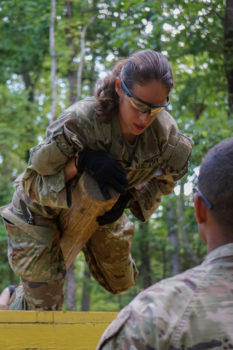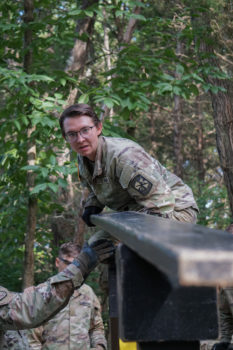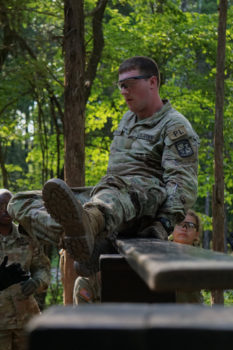FORT KNOX, Ky. – Cadets from 9th Regiment, Advanced Camp, completed the Team Development Course at Fort Knox, Ky., July 22, 2023.

The FLRC consists of different obstacles that are designed to mentally and physically challenge Cadets. They must learn to critically think, solve problems, and work together as a team to find the solutions to the obstacles.
The purpose of the FLRC is to train Cadets how important communication is within a team and to build confidence in one another.
Cadet Catherine Saumell from Texas State University, trained on an obstacle that consisted of tall heavy blocks of wood that were all different sizes. Samuell’s team had to figure out a way to send everyone safely across the obstacle.
A rule to every obstacle at the FLRC, Cadets can not touch any parts of the yellow. The point of the rule is to make the obstacle difficult.
Cadets are given a short time limit to complete each obstacle. If they touch the yellow, they have to restart from the beginning. Saumell mentioned what was challenging about the obstacle.
“It was jumping over to the other side because there wasn’t enough space, but I think we didn’t understand that we could utilize almost everything that was on it,” Saumell said.
Cadets bring lots of skills and talents to the FLRC event, Samuell mentioned her strength.
“I’m a lightweight so everyone can just carry me,” Saumell said.

Cadet Madison Hughes from Embry-Riddle Aeronautical University, trained on an obstacle that consisted of a rope and long wood boards. Hughes’s team had to figure out how to create a bridge in order to send his team safely across the obstacle. Hughes mentioned what was tough about the obstacle.
“The noise discipline that we had to continuously keep. It’s really hard to work together as a team when there’s not a whole lot of communication that can happen,” Hughes said. “I want to say that the second part was that I’m a little bit afraid of heights. [My team] having me go first and bring all the boards over was a little daunting, but still very fun.”
Hughes was the first to be sent across the obstacle. Hughes mentioned how she was incorporated into her team.
“Balance of being the first one in line and being that person that is okay with taking direction,” Hughes said.
Cadet Jacob Kehlenbrink from Indiana University Bloomington, trained on the same obstacle as Hughes. Kehlenbrink mentioned how this obstacle tested him as a leader.
“Trying to get the coordination to make sure everyone’s kind of in sync with each other, making sure that we can all do what we need to do, bounce weight, make sure everything looked right so that it didn’t collapse on us while we were trying to get across,” Kehlenbrink said.
Kehlenbrink held down the fort while he helped his team get to the other side of the obstacle. Then, after his team safety made it across, he crossed the obstacle. He mentioned one of the reasons why his team was able to succeed at this obstacle.

“Working with a team honestly. Being able to work with a team because some people are leaders, but others have to work with each other just to do their best to keep the team going, and keep that morale up,” Kehlenbrink said.




